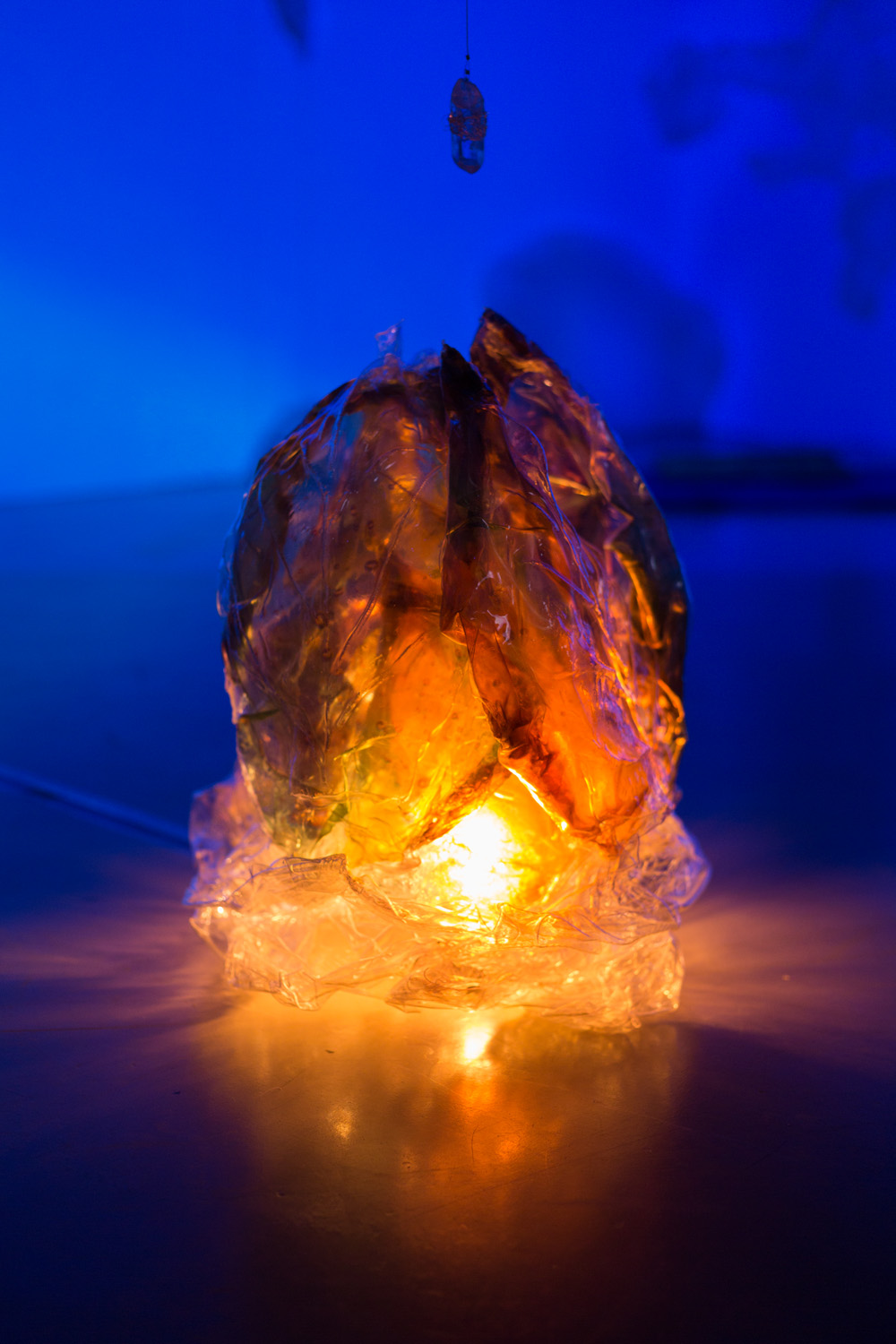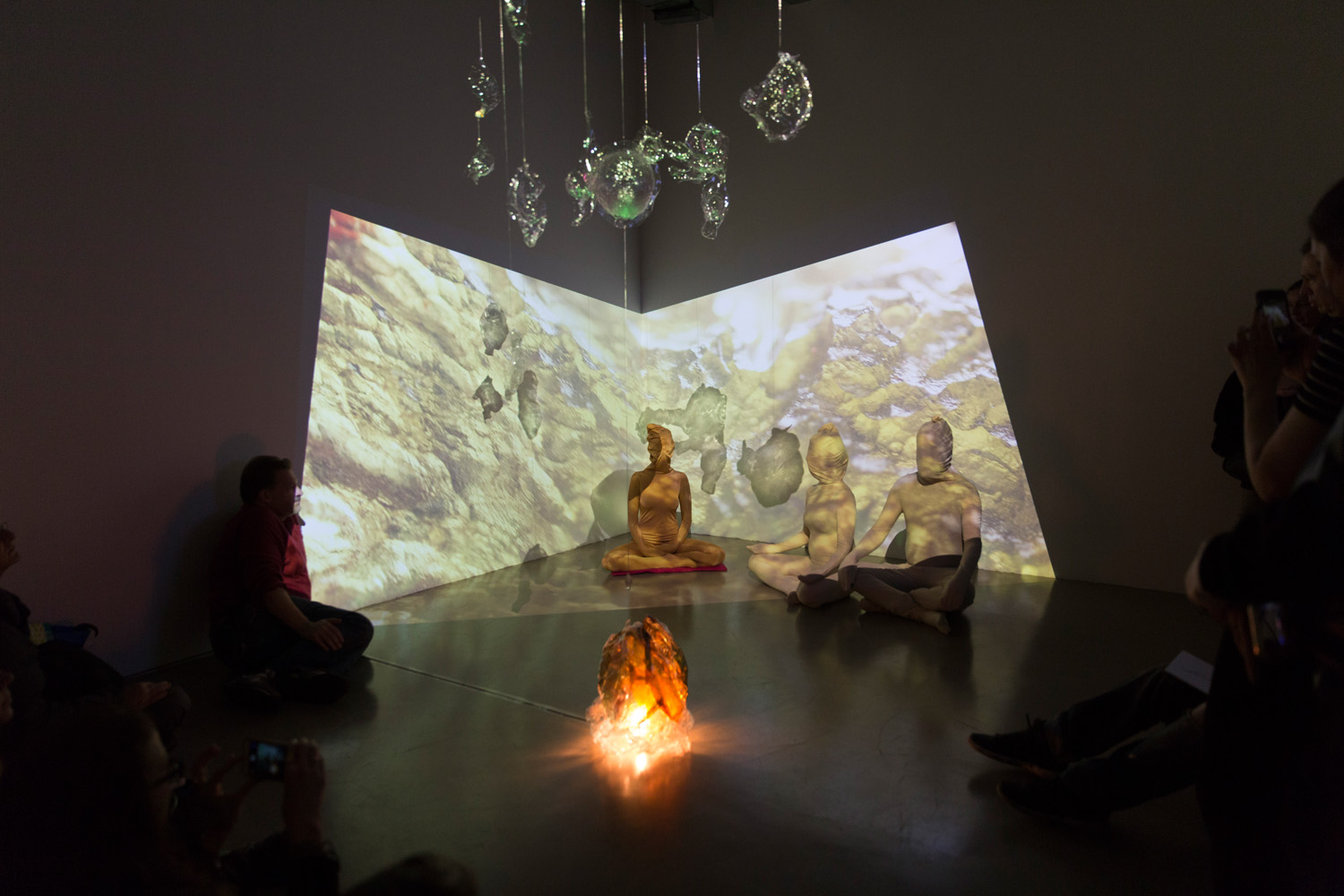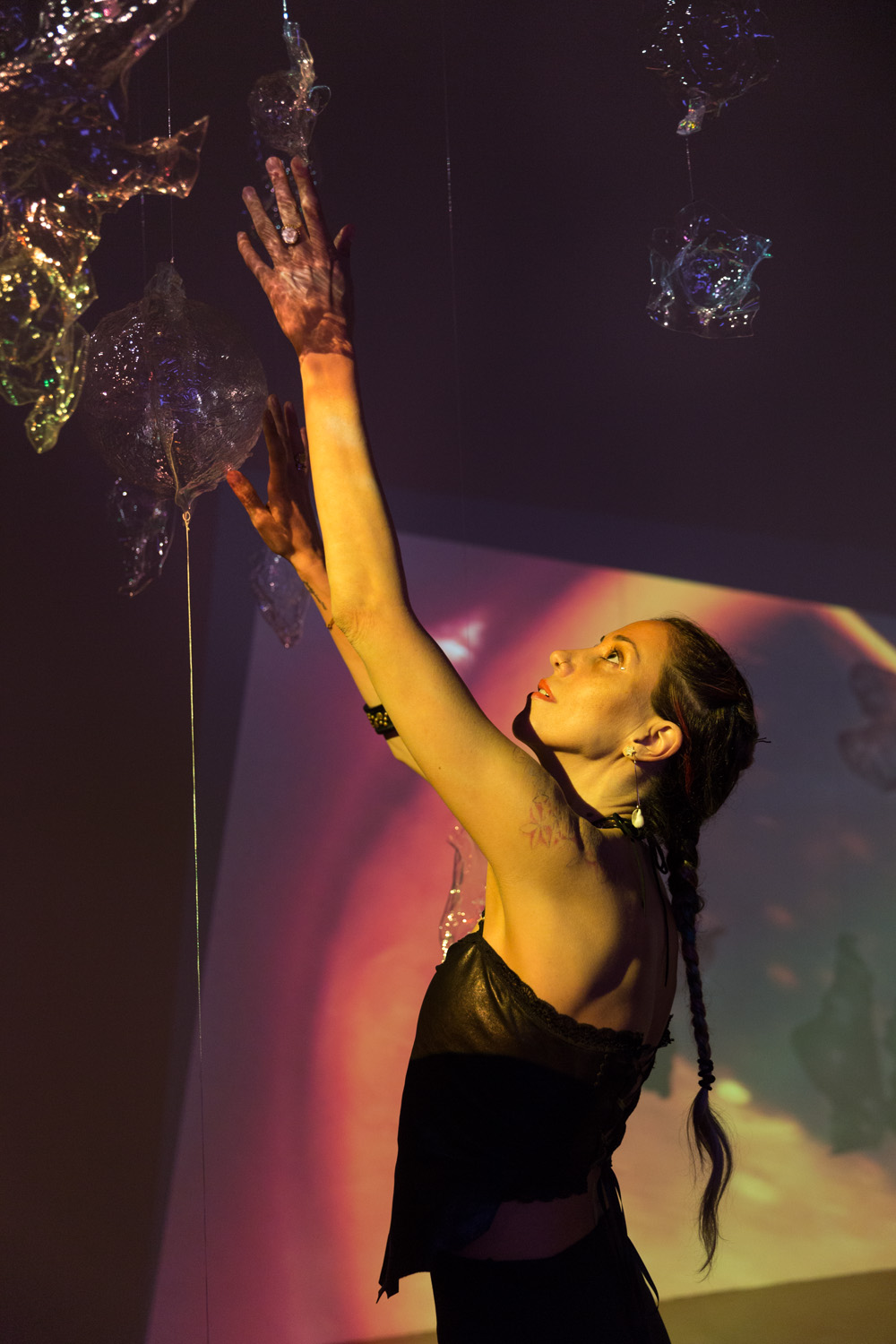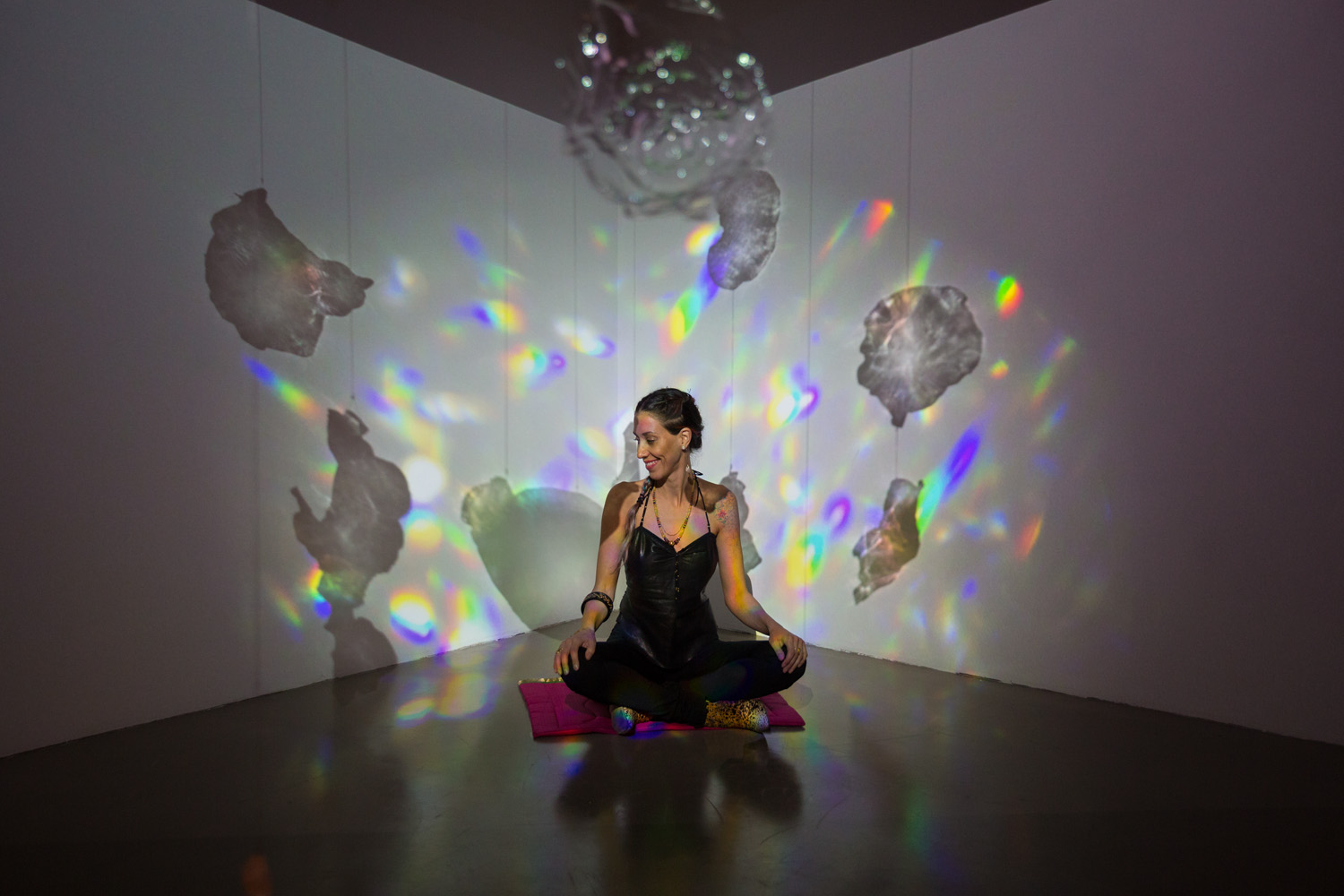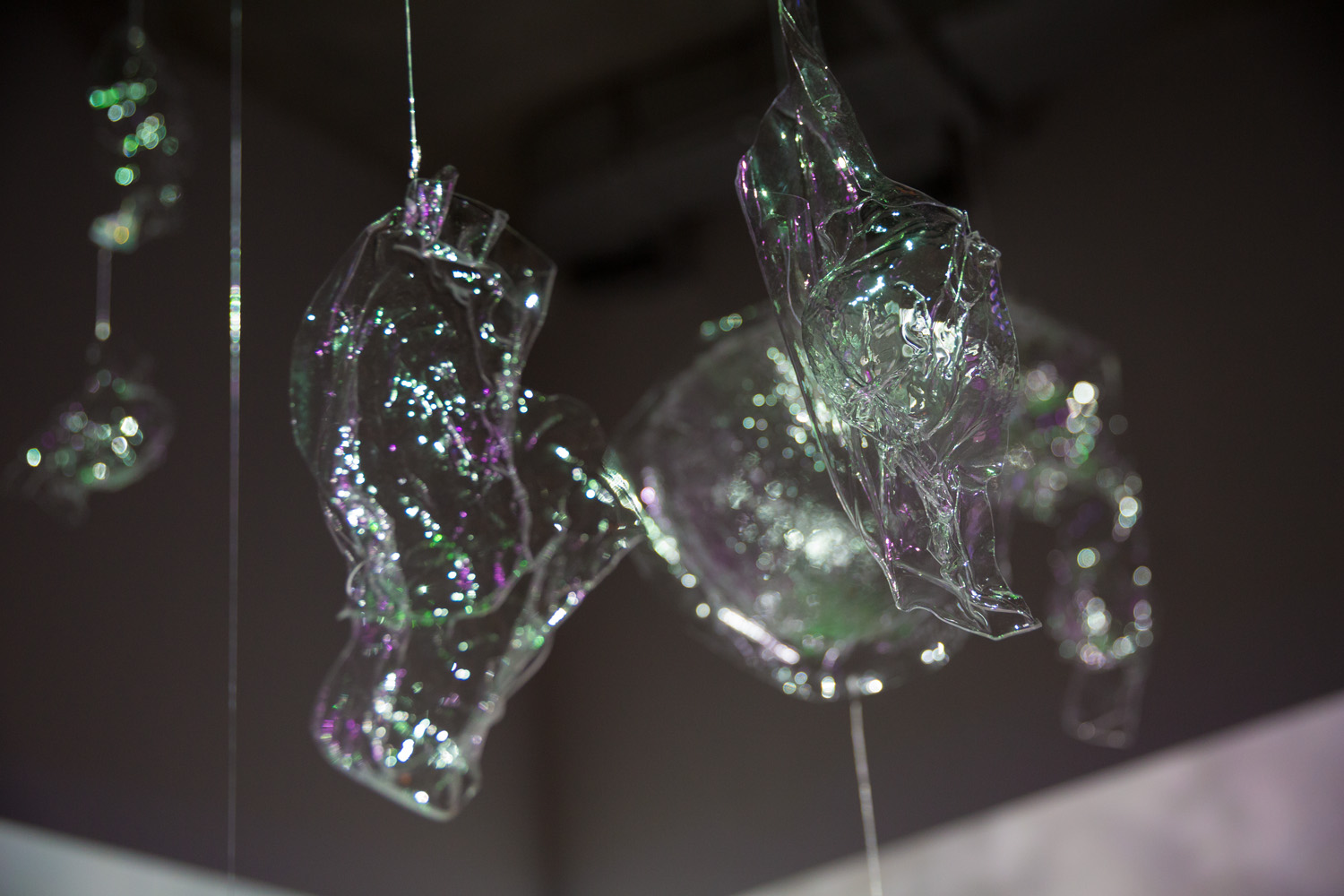
Primadonna Magazine - On the Spiritual in Art
2016 Primmadonna - On the spiritual in art - By Shahar Sarig
Photograph: Beatriz Meseguer / onwhitewall.com
Our artist/correspondent and sex symbol Shahar Sarig in an interview with artist Tal Eshed after her exhibition opening and catalog launch for “Dive In…” at New York’s Tanja Grunert Gallery
Eshed’s current work, as in her previous exhibitions, has a connecting thread between her engagement in other spheres which are part of her professional life, such as Watsu waterdance therapy in particular, and “spiritual” world views in general, and between the art on exhibit. This places her in the very rare group of successful women artists who blend disciplines which are too often perceived as contradictory. The attempt to release the art world from these practices frequently makes artists take a cynical and alienated position. One example is the Guardian’s review of the recent Berlin Biennale of Art, expressing regret that many artists avoid taking the responsibility of making statements or believing that art can benefit viewers. The art world too often sanctifies nonchalance over content – and Tal Eshed’s work is anything but nonchalant. She devotes herself to her attempts to understand, experience, and share. She adamantly refuses to divest such words of meaning and content. Eshed’s current work, similar to her past work, uses sophisticated photographic techniques, integrating them into sculptural elements in a work referring to space in a refined, comprehensive manner. After a hiatus, Eshed is now presenting a performance piece in which viewers were invited to participate in the work by putting on a special suit and meditating in the space together with her.
Our last conversation centered on your trip to New York and the creation of a new expressive channel or a new career and personal path. Now that you have been in NYC for a few years, do you feel a connection to the place? How has your move changed your work?
After my last exhibition at the Rosenfeld Gallery, Tel Aviv, I worked on another one-person show in Israel that did not come to fruition. At the same time, I had an accident that really shook me up and involved a long and complicated rehabilitation process. It also “awakened me” and connected me very strongly to my dreams and my art-making in an extremely clear and precise way. After I regained my strength somewhat, I decided to go back to New York and build the path for myself, the path I believe in, with a clear desire to consciously integrate my art practice with my therapy practice.
Wasn’t this move also associated with a desire to reach a broader audience? Do you feel a tie to the place or do you feel it’s important to create a tie to a place as part of your work? Is it because your themes are clearly universal that place is less important to you?
New York is a kind of home for me, the place in which my art career began about 20 years ago. I always knew I would come back here when the time was right. Back then, one day after I completed my army service, I moved here to study photography and interior design at the School of Visual Arts, as well as other courses. Six months later I had to return to Israel; by then I was accepted by the Bezalel Academy of Art and Design, Jerusalem, and remained to study. Later I continued my MA at Lesley College, but throughout all those years I was back and forth between the two countries. Especially over the past 10 years I looked into possibilities for a significant connection to galleries here. Five years ago I began a relationship with my current gallery [Tanja Grunert] which began to represent me in October 2013. In March 2014, I began to make the tie concrete and began making meaningful art in this city, so that this was definitely part of my broader, comprehensive plan, and not a momentary whim.
Where did your decision to go back to creating a performance come from?
I wanted to extend a direct invitation to viewers to participate in the installation, to facilitate their experiencing themselves in a deeper way through my art-making and process. I selected numerous qualities that are said to have healing capacities and potential, not all of them necessarily visible, but they are present. The process is, of course, healing for me, but also creates a connection to others. What especially engages involves our connections to our own selves, nature, others around us, and the attempts to understand these worlds. The process begins with an understanding of self – surely the most difficult task of all, and something that no one is able to teach us.
Isn’t the very attempt to reach the subject through a uniform activity a paradox?
There are numerous pathways to inspiration and to become reacquainted with my self. The pathways I am proposing – especially in the current artwork – are simply being, here and now, with my own self in my own body with my thoughts, emotions, sensations, and memories. All of the above are present at every moment, and form part of us.
Does this connect with water, which is a major element in this piece and in previous artworks by you. Is it a part of the attempt to speak about something universal?
Our bodies contain mostly water. Liquid leads all of the memories and thoughts we carry with us.
Doesn’t working in New York City or in any other big city contradict the use of elements associated with nature or, say, engaging in nature?
New York is a city overflowing with stimuli, full of art, and an infinite amount of art-making in all disciplines. It is a wonderful place to create and produce art. Nevertheless, a continuous stay in a city is especially challenging to me. I need to hear and see the sea, and feel nature. I need to create places for myself to rebalance from the incessant movement here. I find this balance at the yoga center I attend and in my daily meditation practice and the courses I attend. The river is my refuge to find balance. Anything associated with water, as I see it, keeps me balanced, in movement and motion. But over the years I also took many other journeys, especially to the Far East. I began practicing alternative medical therapies of various types, and over the past decade water therapies in particular. These became part of a whole, and interwoven into my art practice. The various parts that are impacting and being impacted by each other are in a constant, developing dialogue with each other.
Does the city you’re in make a difference for you, say between Tel Aviv and New York? Or is it the difference between urban center and nature? Is it possible to create a work about nature within a city?
The city is part of my challenge to make art of this type. Many of my artworks are made during my travels.
So does that mean your travels become part of the work process? Do you fly – for example, to the Far East - knowing in advance what work process will take place or with a detailed plan?
The vast majority of my work is planned. Of course, there’s always room for flexibility and improvisation, but the foundation itself is planned, and there are always locations, if this is a piece with additional people and costumes and props, everything has to be prepared in advance, obviously. As for the current exhibition, some of the materials were gathered by me over the past five years. Over the past two years, most of it took on solid form. But they all have a source or seeds that began to sprout many years ago. The entire project developed over the years based on work with dancers and models. This is the first time I am actually performing the performance itself.
You haven’t done a performance for a long time – how does it feel to come back to it?
What surprised me was that it was so natural for me because I came from this sphere. As a young girl, I appeared onstage frequently. I was a ballerina for many years until I was forced to quit due to an injury, but I was always connected to the body. My water therapy work brought me back to the pure and unique tie to the body, and, of course, had a huge impact on my art. This may be seen in my artworks from the past decade.
Does the gallery matter as a space? Do you feel it matters in this type of project?
My ambition for the future is to exhibit my work outside the gallery space, in public spaces such as parks or in different places in the world. My desire to bring this experience to as wide an audience as possible is my big dream. The suits worn by the viewers actually make it possible to have an experience very much like the womb experience, a kind of secondary skin enwrapping us, within which we are faceless and cannot be seen. Inside the suit, neither skin color nor gender matter: as the title of the exhibition states, it is a “diving in” to one’s inner world without being able to see outside. The sound inside the space is tuned to the creation of a kind of trance experience intended to bring viewers into an inner space, to go beyond one’s thoughts and physical body.
Do you see a connection between therapy and performance? Does the performance link up with elements of shamanism?
There is something about it linked to shamanism…The “magic” is more of a place connecting to the invisible energies, a place of unification and sharing, a place in which there are no separations or divisions, but only movement, growth and the constant changes of breathing. Through intention and tuned focus during the performance, I undergo that type of process, and invite viewers to take an active part. Thus in essence I am guiding people into a certain pathway in which they can experience something of the world in a particular way.
In your experience, up to now, was it easy for people to feel the things you are talking about?
After a while, there is a kind of giving oneself over. I practiced the meditation for 108 consecutive days prior to the exhibit. During each performance, I sit in meditation for one hour inside of the suit, and invite visitors to participate in the performance. The viewer chooses whether to participate or not. The ones who choose to participate absolutely in the experience itself actually have to put on the suit by themselves. The others choose to participate to the extent that suits them. All are invited, and each experience has its place, all become part of the artwork. The work is in a constant transformation. It exists in and of itself. There is a video of the sunrise in layers, divided into nine months, representing the transformation that takes place simultaneously, but also with a certain tuning and process. There are layers which increasingly add on to the work. There is no limit to the possibilities in the work. The performance adds the important layer of time and of immediacy.
It seems that your artworks also have parts that have parallels to technology and nature. Some of your works have a feeling that they are nearly without material. For example, how did you make the sculptures?
I did a lot of work in a laboratory looking through a microscope, staining cells, and researching water and movement. From the images I saw, I created something that was a transparent gel with pigments, and photographed it. I then printed the results on transparencies that became part of the sculpture. They were placed onto a base, then plastic casts were made over it. Some of the work is also freehand sculpture with a hot glue gun to make a more organic form. All of this actually creates a light element, an “illuminated body.” The process involved work on a tremendous number of layers. It is the world of the micro-macro, the fact that the universe exists within us, the engagement on the cell level and the transformation they undergo – all of the above become part of the stratification and restructuring of the layers of the work.
Do you feel that your world of subjective, private images is important?
I feel that this work is to serve through art, to fulfill a function. It’s not necessarily directly connected to me, I just try to connect people within this very specific space, and the viewers choose by themselves whether to feel something. It’s a subjective choice. I create the optimum space for this exhibition space to be able to remain inside it for a certain amount of time, and to go through a process. The feedback comments I received are amazing.
Did you feel that some people did not succeed in getting something out of the experience? Are you disturbed by the possibility of people judging your artwork only on an aesthetic basis?
Here and there I saw people coming in and going out but on the other hand, those who did stay went through some amazing stuff, even those who had less patience for meditation. But, after they gave in to the experience, there was a transformation, and people realized they had a connection to this. Many people came over to me afterwards with a great many insights. Meditation isn’t about gender or skin color, but about us as living creatures and our connection to our own selves and to the universe. In the final analysis, I’m only the messenger. I want to share the message, but I can’t take responsibility for what the viewer feels – I only invite viewers to become participants.
Translation from Hebrew of an article published in PRIMADONNA online magazine July 13, 2016.
© Artwork by Tal Eshed all rights reserved

